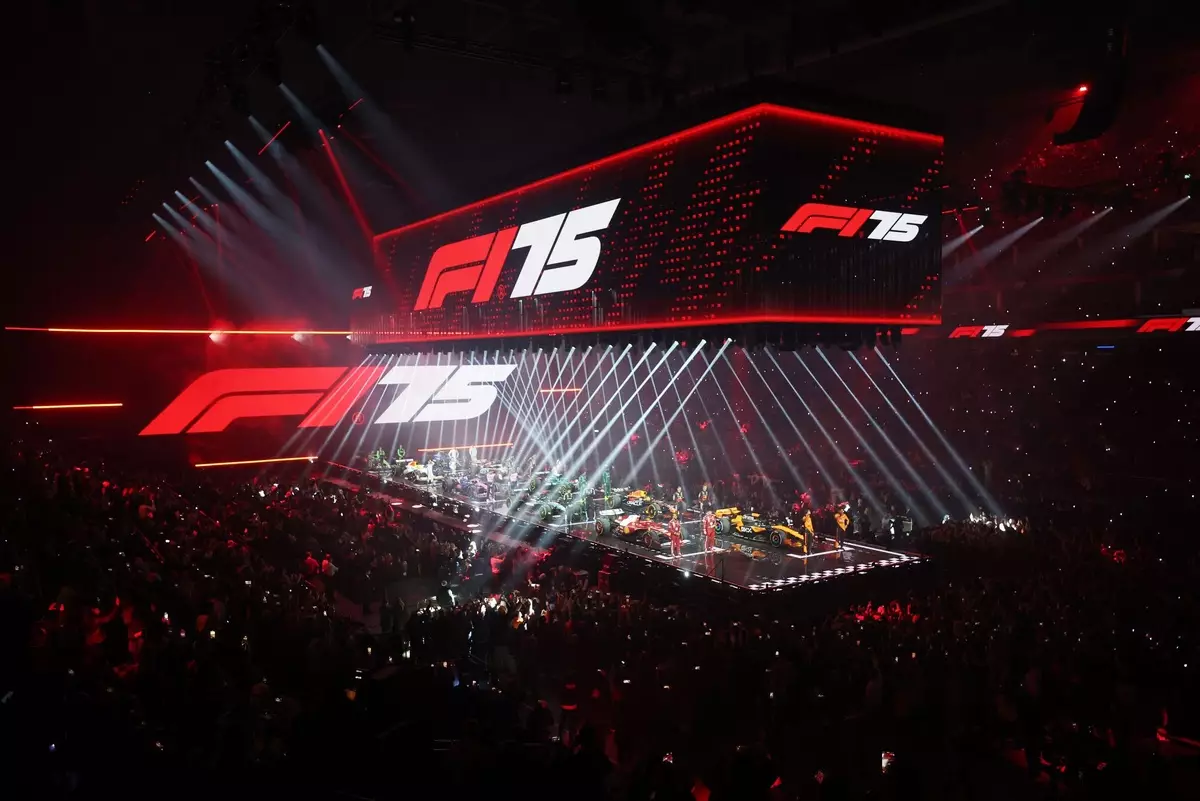The F175 livery launch event marked a significant departure from the traditional, understated gatherings typically associated with Formula 1. Held at the iconic O2 Arena in London, the event showcased the sport’s ambition to capture a broader audience, stepping away from its narrow appeal toward die-hard purists. This shift in focus was evident from the outset, with comedian Jack Whitehall’s quip about the inevitable groans from purists highlighting a palpable divide between longtime fans and a new, younger demographic eager to engage with the sport.
As the lights dimmed and the atmosphere crackled with excitement, it became clear that this event was not solely about unveiling the latest car for the 2025 season. Rather, it was about spectacle—an acknowledgment that Formula 1 must adapt to an evolving media landscape and a fanbase with diverse expectations. The extravagant setup—complete with blaring music and extravagant visuals—was designed to appeal to those unfamiliar with the nuances of motor racing. The event successfully showcased Formula 1 as a sport that is both thrilling and accessible, striving to attract attention beyond the traditional racetrack.
Lewis Hamilton’s appearance at the event served as a pivotal moment, especially since it was his first public appearance in Ferrari red. His reception was nothing short of electrifying, illustrating his enduring popularity and the compelling narratives that surround him. The collective cheers and applause during his segment signified more than mere fandom; they highlighted Hamilton’s stature as a transcendent figure in the sport, capable of drawing in casual viewers while retaining the allegiance of die-hard fans.
Conversely, the reception of Red Bull Racing principal Christian Horner, who walked onto the stage to persistent boos, underscored the complex relationship that modern audiences have with personalities within the sport. Although Horner’s role as a perceived villain has been amplified by the Netflix series “Drive to Survive,” it was a calculated risk for him to lean into this characterization. Amid the mockery, he was able to maintain composure, showcasing resilience and an understanding of the entertainment value he brings to the table.
Such moments within the launch provide an opportunity for reflection on how the sport’s key figures not only contribute to its narrative but shape viewer perceptions. The dynamics between popular and unpopular figures reveal how Formula 1 is increasingly becoming a theater of personalities, where entertainment is just as crucial as competition.
One of the most intriguing aspects of the F175 launch was the varying degrees of success exhibited during the car presentations. While teams like Aston Martin drew on the glitz and glamour of their James Bond associations, effectively captivating the audience, other teams seemed to struggle in terms of creativity and audience engagement. McLaren’s nostalgic reference to its championship-winning history was commendable, yet it also revealed an opportunity for teams to better connect with their heritage and present narratives that resonate more deeply with fans.
Despite these highlights, certain shortcomings were evident. The lack of in-depth coverage of important feeder series, such as the F1 Academy and Formula 2, felt like a missed opportunity to spotlight the broader ecosystem of racing. Additionally, the absence of live car demonstrations—a staple at many motorsport events—left a yearning for more visceral excitement, highlighting an inconsistency in the presentation format that could be refined in future iterations.
Ultimately, the F175 launch signifies not only a new chapter for Formula 1 but also a delicate balancing act between tradition and modernity. While purists may lament the over-the-top theatrics and commercialization, it is crucial for the sport to embrace change if it is to thrive in an increasingly competitive entertainment arena. As F1 seeks to broaden its appeal, there will inevitably be missteps, as seen in the event’s variable presentation quality. However, these can be viewed as part of a necessary evolution.
The overwhelming success of this event—despite its imperfections—demonstrates that there is significant appetite for a more engaging and spirited Formula 1. As the sport harnesses the power of new media and global fan engagement, it is poised for a resurgence that captivates both seasoned fans and a newer generation intrigued by the drama and spectacle of motorsport.
In this light, the F175 livery launch should be viewed as an inspiring milestone—one that emphasizes innovation, audience engagement, and the ever-evolving narrative of Formula 1 racing. It stands as a testament to the sport’s commitment to renewing itself for future generations while navigating the complex web of historical expectations and modern aspirations.


Leave a Reply